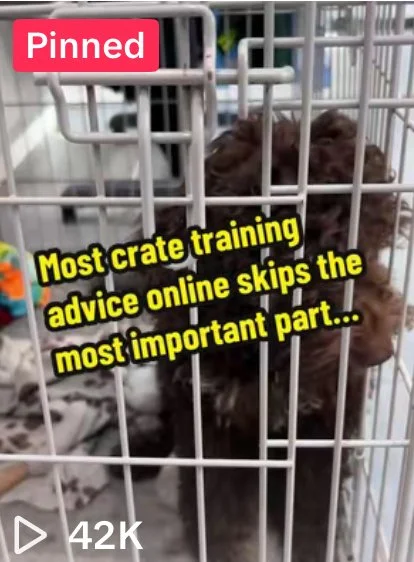6 Crate Training Mistakes I See Most Often — and How to Fix Them
Crate training is one of the best things you can do to raise a calm, confident puppy — but let’s be honest, it’s not always smooth sailing.
As an accredited and certified trainer working with new dog parents every day (especially doodle breeds), I’ve seen the same mistakes crop up again and again. The good news? They’re easy to fix once you know what’s going wrong.
Whether your puppy’s whining, having accidents, or just won’t settle, this post will show you what to change — and how to make crate training work for you.
❌ Mistake 1: Only Using the Crate at Night
It’s super common to treat the crate like a “bedtime box.” But if your puppy only goes in there when you leave or it’s dark, they’ll start associating the crate with being alone — not rest and safety.
✅ Fix it:
Start using the crate for naps during the day. Pop them in with a chew or stuffed Kong when they’re already sleepy. This builds a positive pattern of calm rest, not just separation.
❌ Mistake 2: Closing the Door Too Soon
We all want our pups to stay in their crate quietly — but slamming the door shut before they’re comfortable can trigger panic and vocalisation.
✅ Fix it:
Practice "door open" crate games first. Let your puppy go in and out freely, rewarding calm behaviour. Gradually close the door for short periods while they’re relaxed, building up slowly.
❌ Mistake 3: Skipping the Nap Schedule
Overtired puppies = chaotic crate training. Without structured naps, puppies can become wired and cranky — and the crate becomes a battleground.
✅ Fix it:
Follow a predictable nap routine based on your puppy’s age and energy. I include a bonus nap planner in my Crate Training Bundle to make this easy!
❌ Mistake 4: Using the Crate for Time-Outs
Using the crate as a punishment after biting or zoomies sends the message that the crate = trouble.
✅ Fix it:
Make the crate a safe space, never a timeout zone. Redirect unwanted behaviour elsewhere, then offer the crate during calm moments with a soft tone and reward.
❌ Mistake 5: Not Crate Training You Too
Puppies aren’t the only ones who need crate confidence. Many puppy parents feel guilty using it, or unsure how long is “okay.”
✅ Fix it:
It’s absolutely okay to use the crate for naps, short errands, and rest. You deserve a break too — and your puppy benefits from learning independence.
❌ Mistake 6: Giving Up Too Soon
When whining or accidents happen, it’s tempting to think “crate training doesn’t work for my dog.” But most issues stem from inconsistent use or missing steps.
✅ Fix it:
Stick with it. Crate training isn’t about perfection — it’s about progress. Keep things positive, stay patient, and reach out if you need support.
🎁 Want the Full Crate Training Toolkit?
If you want to avoid these mistakes and feel 100% confident, I’ve created a Crate Training Bundle that includes:
✅ Printable Crate Confidence Tracker
✅ Crate Games + Settle Cheatsheet
✅ Common Mistakes Mini-Guide
✅ Bonus Nap Schedule
Now for just £9.99 (usually £15.99)
This bundle has helped hundreds of puppy parents like you take the stress out of crate training — and I’d love to help you too.
